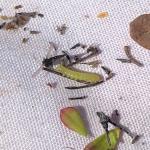Perhaps all the recent rain events and frost management have caused you to notice consistent waterlogged areas on the bog. Before applying any chemicals, improve drainage. Poor drainage prevents rapid drying, weakens vines, and makes the plants susceptible to the infections by fungal pathogens (Phytophthora root rot and fruit rot). Poorly aerated root zones limit the plants ability to acquire nutrients from the soil. Proper soil drainage results in optimal aeration of roots, healthy vines and improved fertilizer use efficacy.
Gypsy moth, false armyworm, winter moth, black headed fireworm and weevil have all been seen, albeit in very low numbers and still quite small. It is absolutely time to do some sweeping to see what you have. Temperatures will finally reach into the 70’s next week and will bring all the bugs out. Erika from Ocean Spray reported a few hotspots inland with counts >15 for weevil. She observed that the buds look good, most locations starting to go into bud elongation, with a few of inland bogs with tighter buds though. This probably won’t last long with the predicted nice weather coming up. She did see a couple 2- and 3-year-old beds (either Rutgers or WI) starting to go into roughneck.
Some early season grasses are up and you should treat. Our grass herbicides permit multiple applications and you can take advantage of that depending on what suite of grasses you have. Avoid applying during roughneck if at all possible. Remember, Intensity and Intensity One are the only clethodim products that can be chemigated.
We will be holding a virtual (zoom) Grower Lunchtime Bogside on Monday June 8, 2020 12:00-1:00 PM. One contact hour will be offered. Please contact Robyn Hardy at rmhardy@umass.edu or 508-295-2212 x10 for the meeting information.
(Left) Winter moth. Where’s Waldo? Find 8 winter moth larvae and 1 cranberry weevil playing dead. (Right) Long lost False Armyworm.

